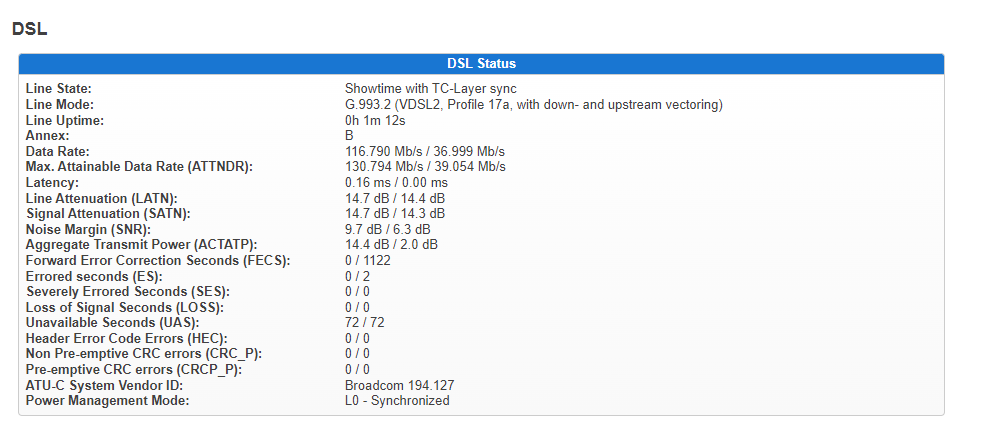At some point, a firmware upgrade on a 3x90 model changed the IP address the boot loader would listen on. I noticed that while running the AVM recovery tool - can you rule this out?
One time I thought it worked when I used 1 instead of the 178 but I couldn't repeat this feat and told myself I must have imagined it!
Nice, thanks for that info, I'll give it a spin.
Looks pretty similar... slight differences in the estimate of the "Max. Attainable Data Rate (ATTNDR)", but your link appears to be limited by the ISP's maximum profile in the downstream direction (assuming a physical German VDSL link operated bei deutsche Telekom, that limit is 116.800 Mbps) and likely by the ISP's DM system in upstream direction (36.999 indicates a hard sync limit at 37.000).
In my link ATTNDR actually fluctuates over the course of a day somewhat, but less than the 3 Mbps you see between the different firmware blobs. However ATTNDR is at best an estimate so it is not clear whether one could realize actually noticably higher sync with the 8.13.1.12.1.7 firmware...
@blogic
A question for you since you commited to various gitlab.com/prpl-foundation/intel repos:
For VRX518 support we require the following firmware files:
The first two don't have a license file at all. The last one has "Intel Confidential Information 10.24.2016"
Are you in a position to poke anyone to get these under something compatible for OpenWrt to use and ship?
I don't know if the latter is compatible, but IIRC the lantiq firmware for VR9 had a special/open license for that reason?
Pushed a few cleanups and a firmware bump we were missing.
I also moved the drivers and firmwares to the lantiq folders. I think that makes sense, it groups the evolution nicely, and 'intel' in not really correct anymore anyway since maxlinear acquired it? Also 'intel/ltq-vdsl-vr11' was confusing already ![]() Does that make sense?
Does that make sense?
can someone help me i can build it with the master but how do i merge the vrx518 in the master branch to make it work with dsl im new to the the one i made has an outdatet kernel so i cant install some apps.
so its great work and working.
Maybe try my vr11 branch, you can use, merge, rebase or whatever:
I Took your Branch and it worked thanks for the help
Receiving a AVM7360 next week. Are we close to a working solution? Would especially like to understand the process to get OpenWRT on it for the first time.
FB 7360 is vrx200 and full supported already
Just booted my AVM 7530 with a first (initram) image. One of the first observations is that the LAN port numbering seems to be reverse, i.e. what the GUI calls out as LAN4 is on de device itself in fact LAN1. Has this been observed before ?
Yeah, I have seen the same thing on the https://github.com/dhewg/openwrt/commits/vr11 branch. I am not sure if the official builds have the same problem (although I assume they probably do). Shouldn't be too hard to fix though.
Did you try these firmwares? What was the result?
I've been running dhewg's branch for a few days with no issues. I get the same sync speeds as my w8980 with fb-7490 DSL firmware. Running as a full bridge (dsl0-eth0) so can't post DSL stats, only what I can see from the ISP side.
DSL Mode
VDSL2
Estimated Distance to Node
318m
Physical Profile
100/40 Standard 6dB
Attainable Rate
142.5 Mbps
50.4 Mbps
Attenuation Average
N/A dB dB
2.5 dB dB
Current Sync Rate
107.7 Mbps
44.2 Mbps
Loop Attenuation Average
N/A dB dB
2.5 dB dB
Noise Margin Average
17.2 dB dB
11.3 dB dB
Shame about the licences holding this back. Could it be merged without the files and have a BYO situation?
Is this a limitation of what is accessible from the chipset? I would have thought with the appropriate NAT rule you could see that in the web interface or with vdsl_cpe_control over ssh. I'm thinking of putting my openwrt device into bridge mode, but I still want to be able to get stats and log them.
Seems only the 7530 and 7590 support Save our Showtime (SOS) and Robust Overhead Channel (ROC). I guess this is maybe a feature of the newer VRX518. I wonder if that works with openwrt? The reason I ask is I'm thinking of buying a new modem with support for those two features and openwrt.
I don't think I'll bother with TP-Link again, nowadays it seems they prefer the shitty Econet/MediaTek chipsets like in their VR2100. Their reps are secretive about it when anyone asks ![]() . When TP-Link does release a model with Broadcom they never shut up about it in their marketing material, such as the VR2800 or the TD-W9970 V3. Both are obviously poor targets for OpenWrt devices. If I'm going to have closed source, and no openwrt support i'd still choose Broadcom over Mediatek though.
. When TP-Link does release a model with Broadcom they never shut up about it in their marketing material, such as the VR2800 or the TD-W9970 V3. Both are obviously poor targets for OpenWrt devices. If I'm going to have closed source, and no openwrt support i'd still choose Broadcom over Mediatek though.
Another thing I noticed with TP-Link is you can't have a management port on a specific dedicated interface with a static route back to your router. Static routes can't be interface specific on TP-Link firmware, and must either be on WAN or all the LAN ports.

